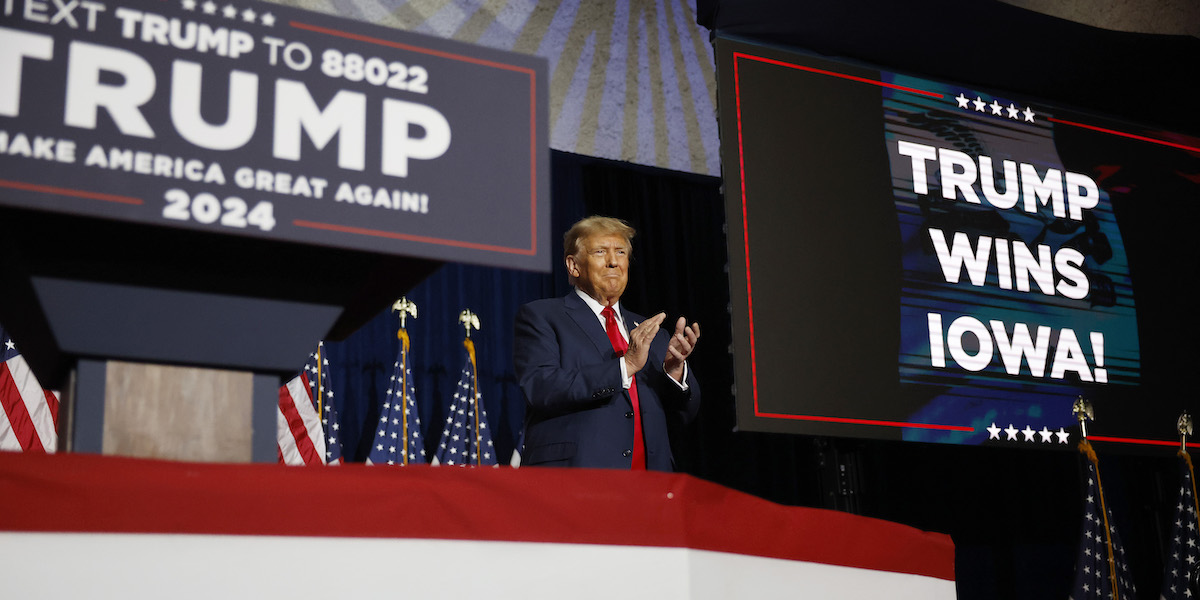Former President Donald Trump largely won the US Republican Party caucuses in Iowa, the first state in which the party’s voters had the opportunity to choose who to run for president in the November 5 presidential elections in the United States. Trump obtained 51 percent, followed by his main challengers: Ron DeSantis, governor of Florida, with 21.2 percent; Nikki Haley, former governor of South Carolina, with 19.1 percent. Entrepreneur Vivek Ramaswamy got 7.7 percent and announced his retirement. Even beyond the victory, it is the best possible outcome for Trump.
In the United States, primaries are mandatory, but the rules change from state to state and from party to party. The caucuses are a more complex form of consultation than the normal “voting at the polling station”: this year the rules of the Republican Party in Iowa required voters to reach the polling stations at 7pm and vote after hearing a speech in favor of each candidate. Since they don’t allow for much flexibility, unlike a normal election where polls are open all day, caucuses typically reward the most organized candidates or those with the most motivated supporters.
On the eve of the vote in Iowa, no one was questioning Trump’s victory: for months the polls had been giving him a large advantage over his opponents, who were also trying to compete for his electorate without placing themselves in open conflict with him and were thinking above all of attacking themselves each other. There were two unknowns about the Iowa caucuses: whether the vote would confirm the size of Trump’s lead and therefore the absence of real competition, and who between DeSantis and Haley would be able to come second and therefore try to establish himself as only alternative.
The Iowa caucuses do not provide definitive rulings on the Republican Party or the country in general: about 110,000 people voted out of 750,000 Republican voters – there were 185,000 in 2016 and 122,000 in 2012 – in a state that has three million inhabitants. However, the results confirm former President Trump’s great hold on the most motivated part of the party’s base, despite the severe cold and snowstorms that were thought to discourage some of his voters; and it is a historic victory, because it has never happened that anyone won the Republican Party primaries in Iowa with more than 13 points. His main adversaries then canceled each other out.
In recent weeks, Nikki Haley had been on the rise in New Hampshire, where she had invested a lot of energy and resources: a state more congenial to her political ideas and the next one in which the primary elections will be held in a week. Haley hadn’t focused much on the Iowa caucuses, but if she had come second she could have credibly presented herself as the only real alternative to Trump and perhaps hoped for a withdrawal from DeSantis, to try to win in New Hampshire and thus reach the elections with momentum. still later primaries held in his home state of South Carolina. It didn’t happen, and now she once again risks splitting votes with DeSantis to Trump’s advantage.
Ron DeSantis, on the other hand, had staked everything on Iowa, investing heavily in it and beating county after county for months in the hope of obtaining a great result that could also launch him in subsequent states: but his electoral campaign never got off the ground and DeSantis was never appeared capable of competing with Trump, who in recent days had begun to attack harshly. Although he has defended second place since Haley’s rise, DeSantis has not obtained a result in Iowa that could conceivably make him competitive in the next states in which they vote.
Iowa is a rural state in the Midwest of the United States, traditionally the one from which the primaries begin: its population is predominantly white, the most important industrial sectors are agriculture and livestock. Until 2010 it was generally considered Democratic, but in recent years it has become the American state to have moved most to the right. Its electorate is historically sensitive to populist candidates, of both parties; in the case of the Republicans, the evangelical religious groups, who support Trump with enthusiasm and money, have a great influence. Contrary to what happened in the past, when the electoral campaign for the primaries in Iowa focused mainly on local issues, this time the campaign was dominated by national issues: inflation, immigration and President Trump’s many legal troubles.
The primaries continue in New Hampshire on January 23, in Nevada between February 6 and 8 and in South Carolina on February 24; the state-by-state vote will continue until late spring, but the Iowa result confirms former President Donald Trump’s great hold on the most active and motivated segment of the US conservative electorate, and makes his candidacy in the November elections almost a foregone conclusion , barring sensational surprises.
The Democratic Party will also hold primaries, but there are no candidates with significant support other than Joe Biden – as almost always happens when there is an incumbent president among the candidates – and the rules provide that the first consultation recognized by the party will take place held in South Carolina on February 3rd. However, one of the consequences of the vote in Iowa could be to establish the irrelevance of these primaries: and immediately begin the electoral campaign for the November presidential elections between Joe Biden and Donald Trump, the same candidates as in 2020.
